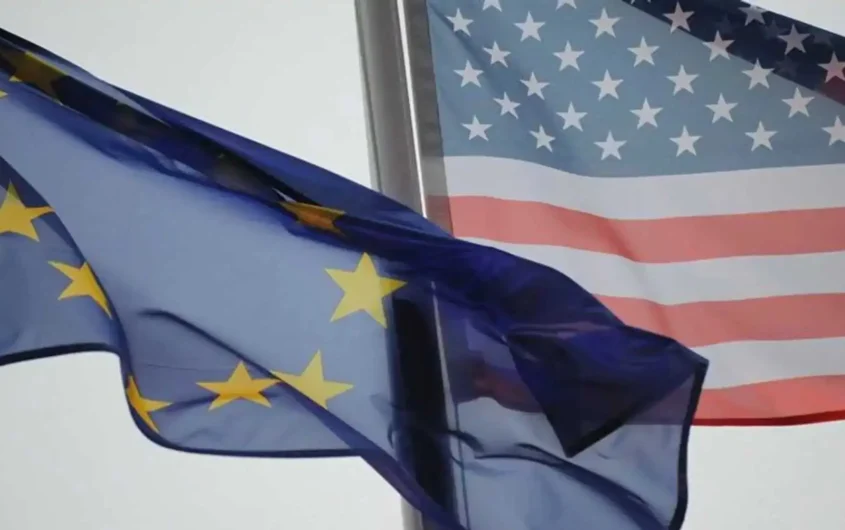
Downing Street via Flickr
U.S.-EU Trade: To Deal or Not to Deal?

Peter S. Rashish
Vice President; Director, Geoeconomics Program
Peter S. Rashish, who counts over 30 years of experience counseling corporations, think tanks, foundations, and international organizations on transatlantic trade and economic strategy, is Vice President and Director of the Geoeconomics Program at AICGS. He also writes The Wider Atlantic blog.
Mr. Rashish has served as Vice President for Europe and Eurasia at the U.S. Chamber of Commerce, where he spearheaded the Chamber’s advocacy ahead of the launch of the Transatlantic Trade and Investment Partnership. Previously, Mr. Rashish was a Senior Advisor for Europe at McLarty Associates, Executive Vice President of the European Institute, and a staff member and consultant at the International Energy Agency, the World Bank, UN Trade and Development, the Atlantic Council, the Bertelsmann Foundation, and the German Marshall Fund.
Mr. Rashish has testified before the House Financial Services Subcommittee on International Monetary Policy and Trade and the House Foreign Affairs Subcommittee on Europe and Eurasia and has advised three U.S. presidential campaigns. He has been a featured speaker at the Munich Security Conference, the Aspen Ideas Festival, and the European Forum Alpbach and is a member of the Board of Directors of the Jean Monnet Institute in Paris and a Senior Advisor to the European Policy Centre in Brussels. His commentaries have been published in The New York Times, the Financial Times, The Wall Street Journal, Foreign Policy, and The National Interest, and he has appeared on PBS, CNBC, CNN, NPR, and the BBC.
He earned a BA from Harvard College and an MPhil in international relations from Oxford University. He speaks French, German, Italian, and Spanish.
In a July 11 letter to European Commission President Ursula von der Leyen, U.S. President Donald Trump announced he would raise tariffs on imports from the European Union to 30 percent on August 1 unless “the EU, or companies within the EU, decide to build or produce products in the US.” In addition to this reshoring option to avoid tariffs, the president offered a second, more traditional path forward, saying, “if you wish to open your hitherto closed trade markets to the United States and eliminate your tariff and non-tariff policies and trade barriers, we may consider an amendment to this letter.”
Will this new challenge from the White House—which increases by half the level of tariffs that could be imposed from the 20 percent “reciprocal” rate announced on April 2—lead to a transatlantic trade deal by the end of the month? The European Union is already sharpening its possible retaliatory response in anticipation of a no-deal scenario, which in addition to tariffs may include the use of its new (but untested) “Anti-Coercion Instrument” that would allow it to close the EU single market to U.S. service providers.
While both the U.S. and EU moves could be seen as “escalate to negotiate” gambits, the risk of major trade conflict remains. On the one hand, EU companies are likely to be hesitant to move their operations to the United States in part because the high tariff environment the U.S. administration is creating will make importing manufacturing inputs—many of which will never be available domestically—prohibitively expensive. On the other hand, while it is true that EU technology regulations like the Digital Markets Act and Digital Services Act could be seen from Washington’s perspective as non-tariff trade barriers because they mainly affect globally dominant U.S. platform companies, it is also the case that these measures reflect strong European preferences about the role of technology in society so may not end up part of a transatlantic bargain.
To get to a deal, the extent of transatlantic interdependence will need to be brought to center stage, both commercially and strategically.
Given these potentially intractable differences, is there a way to avoid U.S. tariff hikes on the EU on August 1 of up to 30 percent? At that level, EU exports to the United States would nearly dry up. And if the EU chose to retaliate, two-way trade could experience the same fate, with severe consequences for economic well-being on both sides of the Atlantic. That means there should be incentives to negotiate a reasonably win-win solution.
To get there, the extent of transatlantic interdependence will need to be brought to center stage, both commercially and strategically.
First, a more realistic assessment by both sides of what could be called the transatlantic balance of economic power would be helpful. Certainly, the EU is dependent on the likes of Microsoft, Google, Amazon, and others for its tech infrastructure. But without German companies like Zeiss or Trumpf or the Dutch firm ASML, the United States would not be able to maintain its worldwide lead in high-end microchip production.
Second, the talks need to be broadened to explicitly include geoeconomic strategy. Kudos are due to European Commission President Ursula von der Leyen for what is now called the Directorate-General for “Trade and Economic Security.” The U.S. administration needs to act with this same linkage in mind. That would mean a recognition during the ongoing trade talks that the two sides will only be able to respond to China’s manufacturing overcapacity and technology challenge with close coordination of ends and means—as well as a world where the United States and European Union are economically strong, rather than unnecessarily weakened through a trade war.








